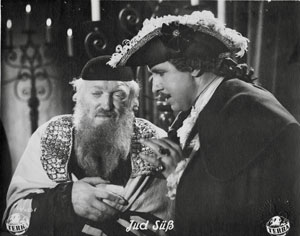

Turner Classic Movies will feature the world television premiere of Marcel Ophuls' newly restored two-part World War II documentary, THE SORROW AND THE PITY (1971), on Wednesday, June 6 at 8 p.m. For fans of this exciting fantasy adventure, this newly restored version of The Lost World is great news because it includes several "lost" scenes from the original version that haven't been seen in over 72 years! Among these scenes are one where the brontosaurus sticks his head into an apartment and disrupts a card game and one where the dinosaur escapes into the Thames River.
Jud suss screenplay online serial#
It will coincide with the release of Jurassic Park 3 but this is the film that started the whole dinosaur film craze! Based on a famous novel by Sir Arthur Conan Doyle, The Lost World originally appeared as a serial in the Strand Magazine in London, England in 1912 and was adapted to the screen in 1925 by Willis O'Brien, the special effects wizard who gave us King Kong (1933). On Friday, July 20, at 8 pm (ET) Turner Classic Movies will air the newly restored version of The Lost World (1925), which was remastered under the supervision of film archivist David Sheperd. TCM Premieres David Sheperd's Restored Version of THE LOST WORLD (1925) It also examines how large and effective the Resistance Movement was, whether the French actually surrendered or collaborated with the Germans and questions the impact the occupation of the troops had on the lives of the French citizens. Ophuls' interpretation of history as the "process of recollection, in things like choice, selective memory and rationalization" is fully illustrated and the second half of the film is devoted almost entirely to interviews, in which the subjects display emotions ranging from mild embarrassment to intense anger.

(Ophuls is available for interviews.) At the heart of part two, "The Choice," is an interview with Christian de la Maziere, one of 7,000 French youth to fight on France's eastern front, wearing German uniforms. The end result is the irony that emerges from these varying testimonies set against newsreels and propaganda films. Ophuls manages to explore the varying perceptions of his subjects and the sometimes-dramatic contrasts between their memories. Those interviewed give unique perspectives on the nature and details of the collaboration as well as the reasons for it, ranging from anti-Semitism to xenophobia and the fear of the Bolsheviks' power to simple caution. The first half of the film, entitled "The Collapse," presents archival footage with 1969 interviews of a German officer, French collaborators and French resistance fighters. His subjects talk openly about how the French supposedly cooperated with the Nazis and how each of them felt about the perception of France being the only country in Europe to collaborate with Germany from 1940 to 1944. He also gathered government officials from France, Germany and England as well as German veterans and journalists/writers who discussed how the French and Germans lived together. Turning his camera on a single French town - Clermont-Ferrand - Ophuls interviewed those residents who not only remembered the war but also would speak candidly about what took place. Ophuls illustrates the differing points of view and varied memories of France's reaction to the Nazi occupation through the use of newsreel footage and a variety of individual memories comprised of factual accounts, perception of events and propaganda. Examining the complex issues of collaboration and resistance, this film gives a clear and powerful portrait of how real people behaved in the face of extraordinary circumstances. This widely acclaimed made-for-French-television documentary looks at the Nazi occupation of France from various perspectives and was the first film to demystify the prevailing myth that France's citizens nobly resisted. Now American audiences can see the film in its original French language version. Presented by Woody Allen, the restored version of the Academy Award-nominated documentary and winner of the National Society of Film Critics Special Award features complete English subtitles for the first time.


 0 kommentar(er)
0 kommentar(er)
